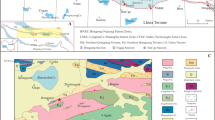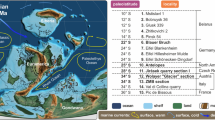Abstract
In the British Quaternary, two post-Cromerian interglacials, the Hoxnian and the Ipswichian, are recognized1. Evidence of additional interglacials in this interval is widely accepted in the oceanic record of Quaternary events2, and the possibility that at least one additional interglacial of this age is represented in Britain has been discussed3–5. However, in the absence of datable interglacial deposits which are seen to overlie one another, the issue has remained controversial. We describe here deposits at Marsworth, UK (Fig. 1) where there is evidence of two temperate episodes, and of intervening periglacial conditions. Stratigraphical superposition is established beyond any reasonable doubt. The later deposit relates to the temperate woodland stage of the Ipswichian Interglacial. Dating of the earlier temperate material by the 230Th/234U disequilibrium method indicates an interglacial episode not previously established in the British Quaternary.
This is a preview of subscription content, access via your institution
Access options
Subscribe to this journal
Receive 51 print issues and online access
$199.00 per year
only $3.90 per issue
Buy this article
- Purchase on Springer Link
- Instant access to full article PDF
Prices may be subject to local taxes which are calculated during checkout
Similar content being viewed by others
References
Mitchell, G. F., Penny, L. F., Shotton, F. W. & West, R. G. Geol. Soc. Lond. Spec. Rep., 4 (1973).
Shackelton, N. J. in British Quaternary Studies (Oxford University Press, 1977).
Sutcliffe, A. J. Quat. Newslett. 18, 1–7 (1976).
Bowen, D. Q. Quaternary Geology (Pergamon, Oxford, 1978).
Shotton, F. W. in Quaternary Glaciations in the Northern Hemisphere IGCP Project 73/1/24 Report, 9 (1983).
Stuart, A. J. Phil. Trans. R. Soc. B276, 221–250 (1976).
Stuart, A. J. Pleistocene Vertebrates in the British Isles (Longman, London, 1982).
Gascoyne, M., Schwarcz, H. P. & Ford, D. C. Trans. Br. Cave Res. 5, 91–111 (1978).
Schwarcz, H. P. Archaeometry 22, 3–24 (1980).
Ivanovich, M. in Uranium Series Disequilibrium (eds Ivanovich, M. & Harmon, R. S.) (Oxford University Press, 1982).
Sutcliffe, A. J. Trans. Torquay nat. Hist. Soc. 13, 1–26 (1960).
Gascoyne, M., Currant, A. P. & Lord, T. C. Nature 294, 652–654 (1981).
Hinton, M. A. C. Monograph of the Voles and Lemmings (Microtinae) Living and Extinct (British Museum (Natural History), London, 1926).
Sutcliffe, A. J. & Kowalski, K. Bull. Br. Mus. nat. Hist. (Geol.) 27, 33–147 (1976).
West, R. G. New Phytol. 85, 571–622 (1980).
Coope, G. R., Shotton, F. W. & Strachan, I. Phil. Trans. R. Soc. B244, 379–421 (1961).
Author information
Authors and Affiliations
Rights and permissions
About this article
Cite this article
Green, C., Coope, G., Currant, A. et al. Evidence of two temperate episodes in late Pleistocene deposits at Marsworth, UK. Nature 309, 778–781 (1984). https://doi.org/10.1038/309778a0
Received:
Accepted:
Issue Date:
DOI: https://doi.org/10.1038/309778a0
Comments
By submitting a comment you agree to abide by our Terms and Community Guidelines. If you find something abusive or that does not comply with our terms or guidelines please flag it as inappropriate.



